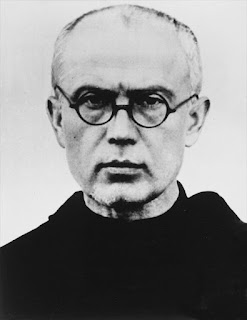fr. kolbe, martyr of charity: 19th week tuesday 2012 II
Today we celebrate the feast of St.
Maximilian Kolbe. He was a priest in
Poland when World War II started. Like
many Catholic priests in German-occupied Poland, together with the Jews, Fr.
Kolbe was led to concentration camps by the soldiers of Nazi Germany. He was imprisoned in the now infamous camp
called Auschwitz . As a matter of policy in this camp, every
time a prisoner escaped nine people were to be executed in his place. So from the group of Fr. Kolbe nine were
chosen to die because one from their number escaped. However one of those chosen to be executed
was so afraid to die pleading with the Germans that he still has a family to
take care. When Fr. Kolbe heard this, he
immediately volunteered to take the place of the prisoner. The Germans consented and that prisoner was
spared for Fr. Kolbe took his place.
They were herded in one room and they were made to die by starvation –
no water and no food. One by one they
died. Fr. Kolbe was the last to
die. In fact they had to inject him with
poison so that they won’t have to wait for him to die for long.
Fr. Kolbe is referred to by Pope John Paul II
as a martyr of charity. Martyrs usually
die to defend the faith, to defend the truth.
For example our would be second saint, Blessed Pedro Calungsod was
killed in odio fidei or out of hatred for the faith. Others die because they want to defend the
truth, the truth of the existence of the one God, and Jesus whom he sent. But Fr. Kolbe was different, he died out of love of
another, he died out of his concern for the well being of another. He died because he felt he could make his
life more worthwhile for the good of another person. This is the martyrdom of Fr. Kolbe. He offered his life in exchange for the life
of a married man who had to take care of his children. When Maximillian Kolbe was proclaimed a saint
the man he saved was still able to attend his canonization at St. Peter’s.
Today we are given another perspective of
martyrdom. If you notice we treat this
kind of martyrdom with a sneer. Ti ano
mapa-martyr ka naman da? Mapa-martyr
-martyr ka pa da nga indi na ina uso subong.
Birahi a, bayai a, bay-i da.
But here is another perspective, the
sainthood of Maximillian Kolbe, the priesthood of Maximillian Kolbe and it
treats this kind of martyrdom not with a sneer nga daw suya, but a hero, a
person we martyr we could look up to rather than sneer and mock. He is a saint, or should I say, this too a
way to holiness, to be a martyr of charity, to be a martyr out of love for
another.
The world in a very subtle way is taking away
this kind of martyrdom from us. Ngaa
mapa-martyr ka imo da man? It frowns on
this kind of martyrdom. Be careful about
this kind of mentality. Ang mentalidad
bala nga kon guba gani ihaboy na lang dayon.
Basi puede pa man makaayo, indi bala.
Kay basi amo man ini sa relationship naton - kon magguba gani bulagay,
kon may diperensya gani ihaboy na lang, itsa fuera, goodbye. This can be true in marriage and in the
priesthood. Kinahanglan gid bala nga
ihaboy? Basi puede man lang makay-o? Indi bala amo na pirme siling sang mga
tigulang sa balay, abi basi puede ta pa makay-o.
And yet you can only do this if you acquire
that attitude of a martyr of charity. We
can never fix things if we do not imbibe this attitude, that I can sacrifice if
called to, that I can be die to myself and my want when the situation requires
it. We can become like Maximillian Kolbe, a martyr of charity.

Comments